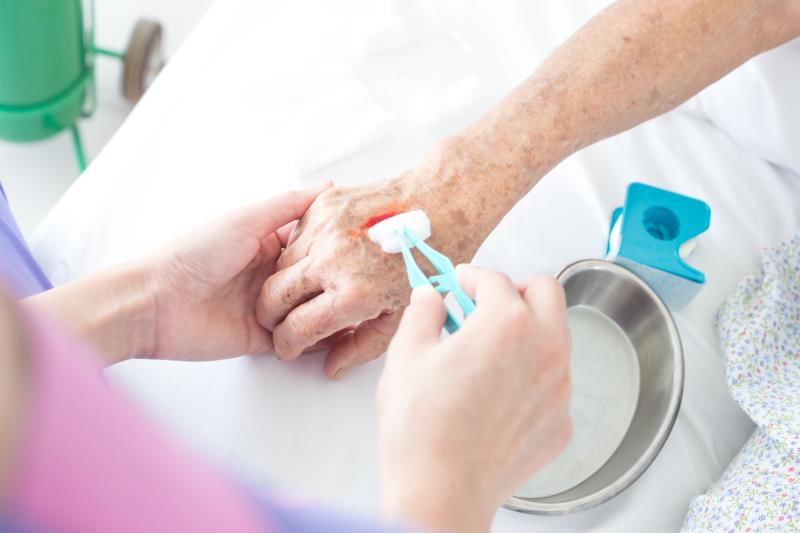
Once-daily oral omadacycline demonstrated noninferiority to twice-daily linezolid in treating acute bacterial skin and skin structure infections (ABSSSI), the phase III OASIS-2* study showed.
“The data suggest that an oral-only, once-daily omadacycline treatment regimen has consistent efficacy, providing physicians with a new potential treatment option for outpatient management of ABSSSI,” said the researchers.
A total of 735 adults (63 percent male, 91 percent Caucasian) with ABSSSI (lesion size ≥75 cm2) and a systemic response to infection were randomized 1:1 to receive oral omadacycline (450 mg once/day for the first 2 days followed by 300 mg once/day) or linezolid (600 mg twice/day) for 7–14 days. Omadacycline and linezolid recipients were treated for a mean 8.2 and 8.0 days, respectively, with 78 and 76 percent, respectively, receiving treatment for 7–10 days. Median lesion size was 322 and 294 cm2 in omadacycline and linezolid recipients, respectively.
Forty-eight to 72 hours after the first drug dose, patients in the modified intention-to-treat population (mITT**) who received omadacycline and linezolid had comparable (early) clinical response, defined as ≥20 percent reduction in lesion size without rescue antibiotics (88 percent vs 83 percent, percentage-point difference 5.0, 95 percent confidence interval [CI], -0.2 to 10.3). [Lancet Infect Dis 2019;doi:10.1016/S1473-3099(19)30275-0]
Clinical success at post-treatment evaluation, carried out 7–14 days after the last dose, remained similar between omadacycline and linezolid recipients both in the mITT (84 percent vs 81 percent, percentage-point difference 3.3, 95 percent CI, -2.2 to 9.0) and clinically evaluable population*** (98 percent vs 96 percent, percentage-point difference 2.3, 95 percent CI, -0.5 to 5.8). This was determined as resolution of infection without the need for further antibiotics.
By treatment end, lesion size had reduced by a median 98 percent from baseline regardless of treatment regimen. There was also comparable efficacy between omadacycline and linezolid for ABSSSI caused by the commonest pathogens including MRSA# (86 percent vs 79 percent), Streptococcus anginosus (89 percent vs 80 percent), and Streptococcus pyogenes (69 percent vs 56 percent).
Treatment-emergent adverse events (TEAEs) occurred in 54 and 37 percent of omadacycline and linezolid recipients, respectively, with 38 and 14 percent, respectively, deemed treatment-related. Serious TEAEs occurred in five patients in each group, with three and two omadacycline and linezolid recipients, respectively, prematurely discontinuing treatment. Nausea and vomiting occurred more frequently in omadacycline than linezolid recipients (30 percent vs 8 percent [nausea] and 17 percent vs 3 percent [vomiting]), primarily in the initial, loading-dose phase, and were mostly mild-to-moderate, leading to discontinuation in just one omadacycline recipient.
With the OASIS-1 study demonstrating the efficacy of intravenous omadacycline in ABSSSI, the present results suggest that both oral and intravenous omadacycline could be utilized for these infections, with the oral option presenting an opportunity for outpatient treatment, the researchers said.
“The strength of the OASIS trials was their ability to show omadacycline’s consistent efficacy in the treatment of severe skin infections with large lesions … and in a population with high proportions of identified bacterial pathogens, including MRSA,” said Professor Matteo Bassetti from the University of Udine and Dr Elda Righi from the University of Verona, Italy. [Lancet Infect Dis 2019;doi:10.1016/S1473-3099(19)30404-9]
Nonetheless, the researchers noted that the solely US-based population and the large number of intravenous drug users in this study (72 percent) warrants the assessment of the efficacy of omadacycline in other populations.
The efficacy of omadacycline for other pathogens such as tetracycline-resistant Gram-negative bacteria and extended-spectrum β-lactamase-producing Enterobacteriaceae should also be studied, added Bassetti and Righi.